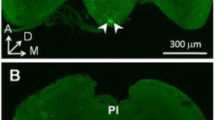Abstract
Serotonin is an important signaling molecule involved in the control of feeding in flies and other animals. In this study, a potential neurohemal release site for serotonin and the effects of exogenous serotonin on protein feeding were examined in the black blow fly, Phormia regina. A dense network of varicose neural processes exhibiting serotonin-like immunoreactivity was identified on the dorsal region of the thoracico-abdominal ganglion in P. regina. This dorsal region of the central nervous system is a likely site for the release of serotonin into the hemolymph. Circulating serotonin may have multiple systemic effects on fly physiology, including modulating or regulating feeding related processes and diuresis. Injections of exogenous serotonin reduced protein meal size in female flies at all doses and at all time points examined within a 24 h period relative to control and saline injected flies. Similar results were observed in serotonin-injected males at 35 min post injection. The injection of 50 μg serotonin resulted in the greatest amount of protein feeding inhibition. Serotonin injected flies also experienced greater weight loss than control or saline-injected flies during the 24 h post-injection period, possibly due to increased diuresis.






Similar content being viewed by others
References
Bernays EA, Simpson SJ (1982) Control of Food Intake. In: Berridge MJ, Treherne JE, Wigglesworth VB (eds) Advances in insect physiology. Academic, New York
Berridge MJ, Schlue WR (1978) Ion-selective electrode studies on the effects of 5-hydroxytrptamine on the intracellular level of potassium in an insect salivary gland. J Exp Biol 72:203–216
Blundell JE, Lawton CL, Halford JCG (1995) Serotonin, eating behavior, and fat intake. Obes Res 3:471–476
Bräunig P (1987) The satellite nervous system- an extensive neurohemal network in the locust head. J Comp Physiol 160:69–77
Brookhart GL, Edgecomb RS, Murdock LL (1987) Amphetamine and reserpine deplete brain biogenic amines and alter blow fly feeding behavior. J Neurochem 48:1307–1315
Chen AC, Friedman S (1975) An isotonic saline for the adult blowfly, Phormia regina, and its application to perfusion experiments. J Insect Physiol 21:529–536
Dacks AM, Nickel T, Mitchell BK (2003) An examination of serotonin and feeding in the flesh fly Neobellieria bullata (Sarcophagidae: Diptera). J Insect Physiol 16:1–21
Davis NT (1987) Neurosecretory neurons and their projections to the serotonin neurohemal system of the cockroach Periplaneta americana (L.), and identification of mandibular and maxillary motor neurons associated with this system. J Comp Neurol 259:604–621
Dethier VG (1976) The hungry fly. Harvard University Press, Cambridge
Downer KE, Haselton AT, Nachman RJ, Stoffolano JG Jr (2007) Insect satiety: sulfakinin localization and the effect of drosulfakinin on protein and carbohydrate ingestion in the blow fly, Phormia regina (Diptera: Calliphoridae). J Insect Physiol 53:106–112
Farmer J, Maddrell SHP, Spring JH (1981) Absorption of fluid by the midgut of Rhodnius. J Exp Biol 94:301–316
Haselton AT, Yin C-M, Stoffolano JG Jr (2006) Occurrence of serotonin immunoreactivity in the central nervous system and midgut of adult female Tabanus nigrovittatus (Diptera: Tabanidae). J Med Entomol 43:252–257
Heisler LK, Kanarek RB, Gerstein A (1997) Fluoxetine decreases fat and protein intakes but not carbohydrate intake in male rats. Pharmacol Biochem Behav 53:763–773
Lange AB, Orchard I, Barrett FM (1989) Changes in haemolymph serotonin levels associated with feeding in the blood-sucking bug, Rhodnius prolixus. J Insect Physiol 35:393–399
Leibowitz SF, Alexander JT (1998) Hypothalamic serotonin in control of eating behavior, meal size, and body weight. Biol Psychiatry 44:851–864
Long TF, Murdock LL (1983) Stimulation of blowfly feeding behavior by octopaminergic drugs. Proc Natl Acad Sci USA 80:4159–4163
Nässel DR (1988) Serotonin and serotonin-immunoreactive neurons in the nervous system of insects. Prog Neurobiol 30:1–85
Nässel DR, Elekes K (1985) Serotonergic terminals in the neural sheath of the blowfly nervous system: electron microscopical immunocytochemistry and 5, 7-dihydroxytryptamine labeling. Neuroscience 15:293–307
Novak MG, Rowley WA (1994) Serotonin depletion affects blood-feeding but not host-seeking ability in Aedes triseriatus (Diptera: Culicidae). J Med Entomol 31:600–606
Orchard I, Lange AB, Barrett FM (1988) Serotonergic supply to the epidermis of Rhodnius prolixus: evidence for serotonin as the plasticizing factor. J Insect Physiol 34:873–879
Pietrantonio PV, Jagge C, McDowell C (2001) Cloning and expression analysis of a 5HT7-like serotonin receptor cDNA from mosquito Aedes aegypti female excretory and respiratory systems. Insect Mol Biol 10:357–369
SAS Institute Inc (2005) JMP start statistics, 3rd edn. Brooks/Cole-Thomson Learning, Belmont
Schachtner J, Bräunig P (1993) The activity pattern of identified neurosecretory cells during feeding behaviour in the locust. J Exp Biol 185:287–303
Smith BK, York DA, Bray GA (1999) Activation of hypothalamic serotonin receptors reduced intake of dietary fat and protein but not carbohydrate. American Journal of Physiology–Regulatory, Integrative, and Comparative Physiology 277:802–811
Stoffolano JG Jr (1974) Influence of diapause and diet on the development of the gonads and accessory reproductive glands of the black blowfly, Phormia regina (Meigen). Can J Zool 52:981–988
Stoffolano JG Jr, Lim MA, Downer KE (2007) Clonidine, octopaminergic receptor agonist, reduces protein feeding in the blow fly, Phormia regina (Meigen). J Insect Physiol 53:1293–1299
Trimmer BA (1985a) The inactivation of exogenous serotonin in the blowfly, Calliphora. Insect Biochem 15:435–442
Trimmer BA (1985b) Serotonin and the control of salivation in the blowfly Calliphora. J Exp Biol 114:307–328
USDA Nutrient Data Laboratory Home Page (2007) Retrieved July 31, 2007 from http://www.ars.usda.gov/nutrientdata
Acknowledgements
This research was supported by the Massachusetts Agricultural Experiment Station (Hatch 817 to J.G.S.).
Author information
Authors and Affiliations
Corresponding author
Rights and permissions
About this article
Cite this article
Haselton, A.T., Downer, K.E., Zylstra, J. et al. Serotonin Inhibits Protein Feeding in the Blow Fly, Phormia regina (Meigen). J Insect Behav 22, 452–463 (2009). https://doi.org/10.1007/s10905-009-9184-1
Revised:
Accepted:
Published:
Issue Date:
DOI: https://doi.org/10.1007/s10905-009-9184-1




